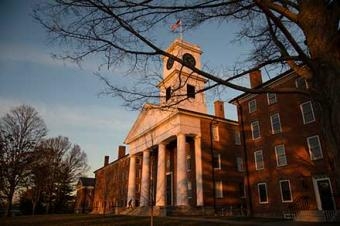You have /5 articles left.
Sign up for a free account or log in.

Amherst College
Amherst College announced Wednesday that it is eliminating the preference it has granted in admissions to legacy applicants since the 1920s.
Currently, 11 percent of Amherst students are legacies.
“Now is the time to end this historic program that inadvertently limits educational opportunity by granting a preference to those whose parents are graduates of the college,” said Biddy Martin, president of Amherst. “We want to create as much opportunity for as many academically talented young people as possible, regardless of financial background or legacy status. There should be no doubt that a world-class education is within reach for students from all income groups.”
An FAQ posted to the website by the college said, “The use of legacy admission preference has never compromised very high standards -- admitted children of alumni are highly qualified, academically and otherwise. With this change, there will be neither an advantage nor a disadvantage to children of alumni; academically well-qualified children will be considered using the same criteria as the rest of the applicant pool.”
The FAQ also said, “After more than a year of study, the leadership and board determined that ending legacy preferences … would further expand our ongoing efforts to increase the diversity and variety of lived experience of the students attending Amherst. We are proud to be among the first of our peers to take this important step towards a more equitable system of higher education.”
One question in the FAQ was, how will the change affect alumni giving?
The answer, “We studied and debated this decision carefully before moving forward; ultimately, we believe that ending the legacy preference will have a significant positive impact on the college’s ability to deliver on its mission of opportunity and accessibility. We anticipate that this commitment to our mission will resonate with many alumni.”
Amherst also announced that it would add to its financial aid program. Under the new policy, Amherst will spend $71 million on aid next year, an increase of $4 million.
“With this enhancement, most students with total family incomes below $141,000 will receive a scholarship of at least $60,700 per year, an amount equal to Amherst’s tuition this year. And most students with total family incomes below $67,500 will receive a scholarship of at least $76,800, which is Amherst’s comprehensive fee for tuition, housing, and meals this year.”
Amherst is this year celebrating its bicentennial. The class just admitted this fall is 50.2 percent nonwhite and domestic. (Another 12 percent of students are international.)
These demographics represents substantial change for the college, which has long had a reputation for mostly educating white students from wealthy New England families. It is among the most expensive colleges in the country (tuition, room and board of $76,800 last year). It is a true liberal arts college at a time when many people are questioning the mission of liberal arts institutions. It’s a small college, with a little more than 1,800 students, in a small city in Massachusetts. Minority students can be reluctant to seek out a college in such a location.
Viet Nguyen, a Brown University graduate who recently founded a group of young alumni who vowed not to donate money to their alma maters if they continue legacy admissions, praised Amherst’s move. He said that just as colleges must improve their financial aid policies to attract students, so too colleges eliminating the legacy preference without also providing more aid won’t bring about real change. (Nguyen said his group has some Amherst alumni, who will be notified of the college’s change.)
He said his organization would soon send notes about Amherst’s decision to the boards of private colleges with legacy admissions. The message will be “This can be done,” he said.
But will other colleges follow Amherst’s lead?
Johns Hopkins University ended legacy admissions in 2019, and the Massachusetts Institute of Technology and California Institute of Technology do not use legacy admissions. However, most competitive private colleges do. Governor Jared Polis of Colorado, a Democrat, signed legislation in May to bar legacy preferences in admissions by public colleges and universities in the state.
At Hopkins, university administrators shifted the legacy policy gradually, starting in 2014 before ending it officially in 2020. In 2013, 8.5 percent of admitted students at Hopkins were legacies, 8.1 percent of the class was first generation and 12.8 percent of the class was eligible for a Pell Grant. This year, with the policy fully in place, only 3.7 percent of the class is a legacy admit, 17.8 percent are first generation and 20.1 percent were eligible for a Pell Grant.
Williams College, another elite private liberal arts institution in Massachusetts, offered qualified support for Amherst’s decision, although no indication that it would follow Amherst.
“The Amherst announcement is a fresh entry in the ongoing reconsideration of college admission practices, and we support them in making the choice that was right for them,” Williams said. “At Williams we’re expanding our own efforts to build diversity and provide what we call ‘true affordability’ by expanding our financial aid to include students’ health insurance and all required books and course materials, as well as reducing the cost to middle-income families by revising our financial aid methodology … It’s through such efforts that Williams, Amherst and our peers are trying to make an outstanding education more affordable and accessible to the students and families we serve.”
One group that has defended legacy admissions is the Council for Advancement and Support of Education. Robert Moore, vice president for marketing and communications of CASE, said the Amherst decision did not change CASE’s policy.
“CASE strongly asserts that legacy status should never be the sole criterion for acceptance to a college or university,” he said. “Institutions develop admissions criteria to ensure that each entering class is comprised of students who show the potential to succeed and who will take advantage of the specific opportunities that the institution can offer. At some institutions, an applicant’s legacy status is given consideration; in those instances, the advancement professionals that CASE serves are asked to work with their colleagues in admissions when institutional structures and guidelines warrant such interaction. In other institutions, no interaction between advancement professionals and their admissions counterparts takes place.”








